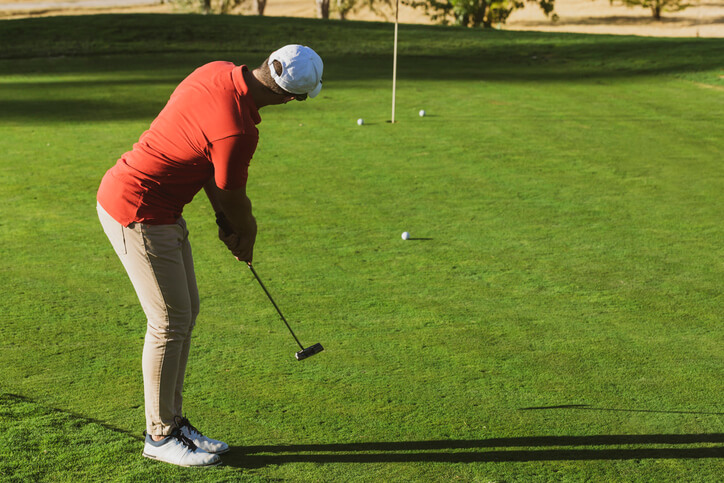How to read golf greens like a pro
05 August 2025

Few skills can make or break a game of golf quite like putting. It’s the final flourish, the chance to apply that all-important finishing touch, and potentially the difference between par and a bogey.
But for such an important part of the game, putting is very difficult to master. This is for many different reasons, chiefly the variation: every green is different.
Because of this, learning how to read golf greens can turn a poor round into a good one. It could also transform your golf game more broadly, whether you’re a beginner or an experienced golfer. Here are some helpful tips for how to read a green.
What is reading the green?
First things first, it’s important to understand what is meant by reading a golf green and why it’s so important for your putting game.
In short, ‘reading the green’ refers to assessing the surface of the green to determine the direction and power of your putt. This is so important because all greens are unique and have their own quirks. They may look flat, but they rarely are. There are contours, slopes and undulations on each green that won’t be replicated on any other.
You can’t simply play the same shot from the same distance on two different greens because, thanks to these discrepancies, the results might be markedly different. So, establishing how to adapt your shot for each green is critical for your putting game. With that in mind, here are some tips to consider when reading the green.
How to read a green in golf: Before your shot
It’s important not to wait for the moment of your shot to decide its path and speed.
Start early and take it slow
As soon as you approach the green, start taking notice of the overall shape of its surface. Look for the obvious, like any visible slopes and ridges. This way, you can get a feel for the general shape of the green.
Make sure not to rush this process. It’s best to walk while making these initial observations. You need to give yourself ample time to get to grips with the surface with which you’re working.
Use your feet and check from all angles
Walk on the green itself. Use your feet as a guide to determine the shape, inclines and declines of the terrain which you might not have seen at first glance.
Observe the green from multiple angles, too. This will allow you to make observations you might have otherwise missed and give you a broader picture.
Consider the conditions
The shape of the green itself isn’t the only factor that will affect your shot.
For example, the weather will play a part. If the grass is wet, your shot will be met with more resistance, making it slower. As a result, you should hit the ball more powerfully. On the other hand, a dry green can result in a shot that is naturally much faster and requires less power.
Additionally, something as simple as the sun and shadows being cast on the green can mislead you into seeing things that aren’t there. The wind can also play a part, even though the ball will largely remain on the ground—determine which direction the wind is blowing and how strong it is in order to gauge where the ball may roll on the green.
While these conditions can influence your shot, they also highlight how golf engages both body and mind. Playing regularly can offer a range of health benefits, from improving your cardiovascular fitness to boosting your mental wellbeing.
Pay attention to the grass
The grass grain, or the direction in which the grass has grown on the green, has a noticeable influence on the speed of your putt. If it is growing towards you, the ball will move more slowly. If it is growing away from you, it will be faster.
The length of the grass also has an impact. Longer grass will result in a slower shot, whereas shorter grass will make the ball move quicker.
So, ensure you’ve established the grass’s characteristics to determine how much power to use for your putt.
How to read a golf green for putting: The process of putting
The job isn’t yet done when the ball is in place and you’re ready for your putt. From here, you can make some more specific observations that are unique to the position of the ball in relation to the hole.
Assess the break
The break refers to how far from right to left, or vice versa, your putt will go. It’s a crucial element of determining a path for your shot, and it’s different for every shot on every green.
To visualise how the ball will move as a result of the break, crouch behind to get as close to eye level as possible. This will help you spot any more slopes or contours you may have missed.
You can also deploy the plumb-bob method, whereby you hold your putter in front of you with the head dangling. Close one eye and line it up with your envisioned path. If the head hangs left, that’s where the green is sloped, and vice versa.
Once you’ve got an idea of the path your ball will take, you can even walk it to further envision your putt and find any other dips or rises on the green.
Aiming
Now you’ve established the break, aim towards this instead of the hole itself. It’s no good aiming directly at the hole if there’s a significant break that will send the ball too far left or right. Use the terrain to your benefit and find a particular spot you want to aim at.
Determining the highest point of your line is also important. Aim towards there, and gravity will do the rest, bringing the ball back down again.
Consider distance
The further away from the hole you are, the more pronounced the break will be. This means you should aim further away from the hole when you’re towards the edge of the green. You’ll also need more power from further out.
The closer to the hole you are, the closer to it you can aim and the less power you need.
It’s also important to remember that, if the green is sloping upwards, you’ll need to apply more power. If it is sloping downwards, gravity is again your friend, and you can apply less force with your putt.
Practice makes perfect
Much like any other skill in the sport, learning how to read golf greens will take time, patience and lots of practice. Just remember, regular play and repetition can take a toll on your body over time—it’s worth knowing about the most common golf injuries and how to prevent them.
In the short term, do some practice putts on the green before your round begins. Try shots from a range of distances and angles to familiarise yourself with the green as much as possible. Remember, each green is different.
When it comes to the longer term, it’s all about repetition. The more golf you play, the better you’ll become at reading the greens and using the right technique at the right time. The more you practice, the more consistent you’ll become, and that’s when you’ll really start to excel at a part of the game that is so vital.
Specialist golf insurance through Insure4Sport
Now that you know how to read a golf green, you can approach your next round with confidence. But before you tee off, you might want to consider protecting yourself and your golf equipment with specialist golf insurance.
Through Insure4Sport, there are four golf insurance packages to choose from, depending on the level of cover you need. Get a quick quote online today to find out more.
Please note the information provided on this page should not be taken as advice and has been written as a matter of opinion. For more on insurance cover and policy wording, see our homepage.
Got a question? Call our UK call centre 0800 158 5530
©Copyright Ripe Thinking Limited 2025.
Insure4Sport® is a registered trademark and a trading name of Ripe Insurance Services Limited which is Authorised and Regulated by the Financial Conduct Authority No.313411. Registered office: One Stockport Exchange, Railway Road, Stockport, United Kingdom, SK1 3SW. Registered in England No. 04507332.
